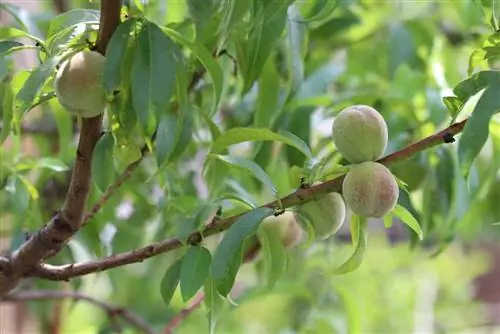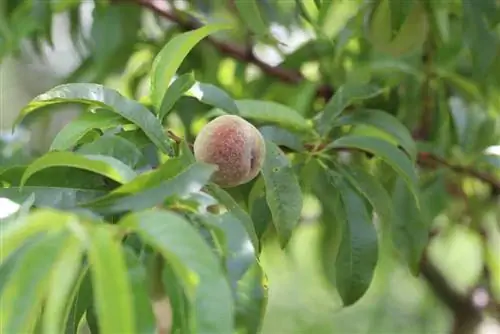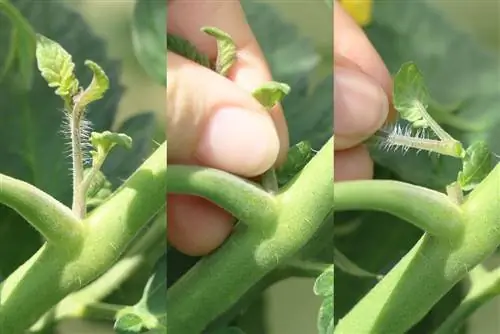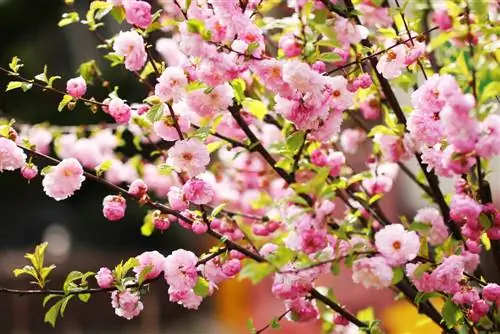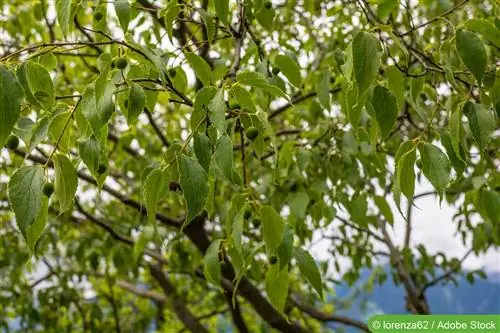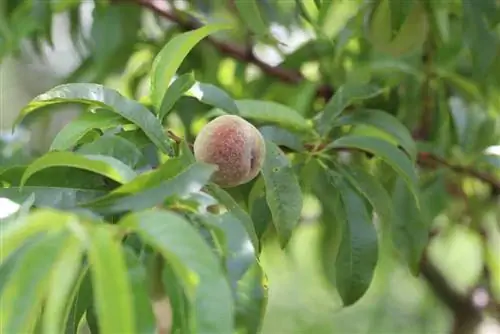- Author admin [email protected].
- Public 2023-12-17 03:39.
- Last modified 2025-06-01 06:48.
It takes a few years before a peach tree grown from a pit bears fruit. In some cases the tree never sets fruit. Whether a seed peach tree produces a bountiful harvest depends primarily on the variety of peach from which the drupe comes. The same applies when it comes to whether the kernel germinates at all or not. We will explain to you in 7 simple steps how you can successfully grow a peach tree.
Seeds
The peach tree, botanically called Prunus persica, is a tree up to three meters high that bears tasty fruit. Like many other well-known fruit trees, the peach belongs to the stone fruit family of the rose family. The tree produces characteristic fruits with a firmly anchored stone core in the flesh. If you want to propagate the plant, such a core can be planted in soil. Each of these stone cores contains exactly one seed.
Which varieties are suitable?
There is a peach tree in every single kernel. However, because cross-pollination between individual varieties can produce very different results, apples, pears and other fruit trees are generally not propagated by seeds (kernels). However, the almond-shaped kernels of peaches often provide the desired properties. Although you can grow plants from the pits of almost all types of peaches, you won't have much fun with most of them because these plants usually remain quite small and rarely bear fruit.
In order to actually be able to harvest fruit after a while, you need a so-called genuine peach variety. True to the core means that the various properties of the mother plant are also transferred to the seedling. This is not necessarily the case with today's cultivated varieties, as they are often hybrids whose seeds either do not produce viable plants or produce completely different properties. Crosses between two trees resulting from pollination by insects also often produce less than desirable results. Coreless varieties are also known as wild peaches.
Genuine varieties
Many peaches, which naturally have white flesh, are seedless and therefore well suited for propagating the plant. These mainly include the following varieties:
- Naundorfer Kernechter (fruit ripening: end of August to mid-September)
- Red Ellerstädter/Kernechter from the foothills (ripe mid to late September)
- White Ellerstädter (harvest from the end of August, beginning of September)
- Proskauer peach (harvest late August to mid-September)
- Ussurian wild peach (late variety)
Pulling a peach tree from seeds - step-by-step instructions
In order for a peach stone to become a stately tree, there are a few things to consider and a lot of patience. Unlike some other seeds, a peach seed cannot simply be planted in a pot with potting soil and will germinate within a few days or weeks. In principle, you can of course plant a peach stone directly in the garden soil in autumn and simply wait to see whether it germinates in spring. However, you will achieve a higher success rate if you store the core until winter and then bring it indoors.
Step 1: Select fruit
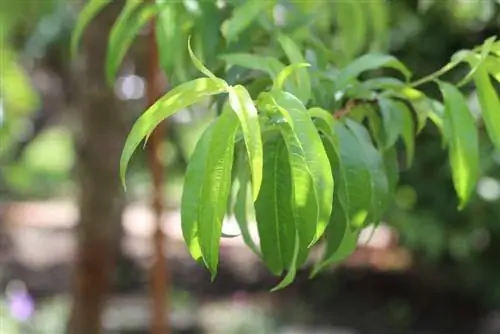
Not only the variety, but also the time at which the peach was harvested determines whether the attempt to grow a peach tree from a stone is successful or not. The seed (including the fruit) must already be ripe at the time of harvest. Unripe peach stones are usually unable to germinate. If you have your own peach tree in your garden that you would like to propagate, simply wait until the fruits are ripe. This is easy to recognize because the tree drops these fruits on its own. Things get a little more difficult if the peaches are bought at a discount store. As a rule, the fruits are taken from the tree unripe and then ripen later in an air-conditioned hall. Therefore, only use fruit that is available in the store during the regular harvest time. Most of these white-fleshed varieties are ready to harvest from the end of August. It's even better to buy the peaches at the market from a local supplier.
- the best seeds come from ripe fruits
- avoid seeds from early maturing varieties
- prefer local varieties and fruits
It is always safer to choose locally grown fruits. On the one hand, there is a greater chance that the fruit was harvested ripe, and on the other hand, this variety has already established itself here. If you buy fruit from southern countries or overseas, this is not necessarily the case.
Tip:
Since many peach stones do not germinate at all and some young plants do not survive the first year, it is safer to grow several seeds at the same time for propagation.
Step 2: Remove pulp
Before propagation can even start, it is important to remove the pulp from the core. If stored for a longer period of time, the sugary, juicy meat would begin to rot or mold, so that in an emergency the core would also be affected. So if you eat a peach in the fall, you can then clean the core with a brush under running water. It is then placed on newspaper or a piece of kitchen paper to dry for a few days.
Step 3: Remove the woody shell or not?
Sometimes the peach is so ripe that the core has already split itself and exposes the seed inside. It is certainly not necessary that you remove the outer covering (woody shell) around the actual seed, although some home gardeners have had success doing so. The risk of damaging the sensitive seed inside is very high with this procedure because the wood is quite hard. The seed naturally germinates easily if it remains in the shell. If you decide to remove the woody shell, follow these steps:
- Let the core dry indoors for a few weeks
- this procedure causes the seed to shrink slightly inside
- so it comes off the shell
- the wood also becomes more brittle and is easier to crack
- It's best to open it carefully with the nutcracker
Tip:
Handle the exposed seed with care. Not only is it very sensitive, but it also contains high amounts of cyanides. Cyanides (s alts of hydrogen cyanide) are very toxic and fatal even in low concentrations (if consumed). Therefore, never leave the seeds lying around unattended if there are other people, animals or even children in the household who could accidentally eat them.
Step 4: Cold Period (Stratify)
Many seeds are equipped with a so-called germination inhibition. This is to prevent the seed from germinating in an unfavorable time of year (autumn or winter) and the young, sensitive plant not surviving the frost. The peach tree is also one of the so-called cold germs. In order for the seeds to germinate, they don't necessarily need frost, but temperatures below 8 degrees.
Variant 1
If you live in a region where the winters are long and cold, you can plant your peach stone directly in the garden soil in autumn or winter. But wait until the summer heat period is over.
- shady location (must not be warmed by the winter sun)
- protected
- humic-sandy soil
- must be well permeable to water
- keep slightly moist (not wet!)
- Planting depth 2 to 4 cm
- cover with brushwood, straw or leaves to protect against severe frosts
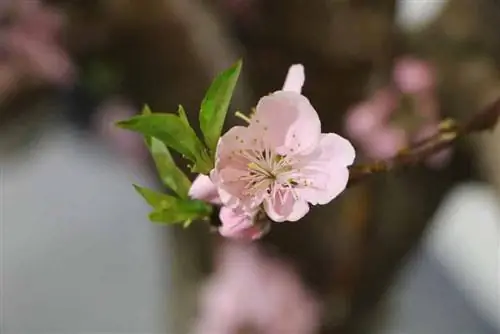
This method does not require any additional measures other than occasional watering to keep the soil slightly moist and is therefore very simple. Disadvantage: If the cold phase is too short or is interrupted by mild weather, germination can be delayed by a year in the worst case.
Tip:
If you have squirrels in your garden, you should put a wire basket or rabbit screen over the core.
Variant 2
The safest method is to expose the peach stone (or several) to an artificial cold period. In warmer areas this is absolutely necessary. To do this, place the core in a bag or container with moist sand and close it. The trick is to keep the kernels slightly moist without mold or mildew forming on them. Before putting the kernels in the bag, you should soak the peach kernels that are still in the woody shell in lukewarm water overnight.
- Time: between December and the beginning of January
- store in the vegetable compartment of the refrigerator until spring
- Period: at least 8 weeks
- alternatively place in a dark, cool cellar or garage (maximum 7 degrees)
- do not store near fruit
Tip:
Seeds that overwinter in the cellar should be protected against mouse damage by a fine wire mesh.
Step 5: Plant the core
In spring, when the peach stone has survived the week-long cold period, it is planted in a humus-rich, permeable substrate. Monitor kernels during stratification, as in one case or another germination may already occur. In this case, the seedling is of course immediately planted in substrate.
- Time: from March (in the house)
- Substrate: cactus soil, growing soil
- must not contain high amounts of nutrients
- Planting depth: about 2 to 4 cm
- Location: warm and bright (without direct sun)
- Always keep the soil slightly moist
- possibly place the pot in a plastic bag
- ventilate occasionally
- Germination time: several weeks to several months
You should treat plants that have already germinated during the cold period very carefully. Place the core on the humus-rich soil mixture that you have filled up to 4 cm below the edge. Pay attention to the planting direction. Of course, the root must be planted downwards and the shoot upwards. If only a small green tip sticks out of the woody bowl, position it downwards. Because normally the root grows first and the actual shoot on the other side only grows much later.
Step 6: Pre-growing the seedlings
If small plants have developed from the peach stones, they should be planted in a pot about 15 cm in size and initially cultivated on an eastern or northern window in the house until the trunk is slightly woody and a minimum size of about 30 cm has. Bring the seedlings sown outdoors back indoors until the temperatures are permanently warm. In order for the young plant to grow he althy and strong, it is necessary that it is very bright, but that the temperatures are not too high. Conversely, at high temperatures and little light, the sprout tends to become very long and thin. These are poor conditions for developing a stable tribe. The slower the young plant grows, the harder its trunk becomes and the better it will later withstand wind and weather.
Step 7: Planting out
Once you have germinated several seeds, choose the strongest (not necessarily the largest) plant and plant it directly in the garden. You can give away the remaining young plants or dispose of them if there is not enough space. It is important to choose the right location and prepare the soil in advance with compost or other organic material. Heavy soils should be made more permeable to water with a good portion of sand or grit.
- Time: mid-May at the earliest
- no more late frosts may occur
- First slowly get used to the outdoors
- place in partial shade to shade for about two weeks
- a little more sun every day
- Substrate: humus-rich, well-drained soil
Tip:
It takes at least four years for peaches grown from pits to produce their first flowers and thus produce fruit.
Selection of the best plants
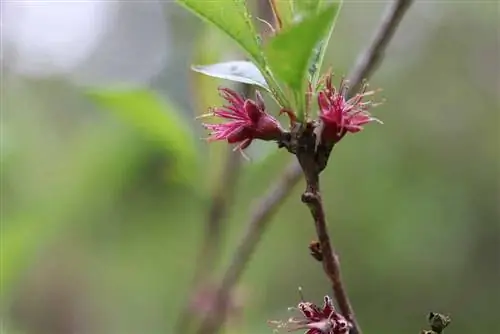
If the plants germinate in spring, you have the opportunity in advance to distinguish particularly large-fruited variants from those that will only bear small numbers of small fruits. The wider the leaves of the young plant, the more beautiful the fruit you can expect.
Location
If you want to harvest numerous and large peach fruits, you should plant the seedling in a location that is as sunny and warm as possible. Peach trees are particularly easy to cultivate in wine-growing areas. In regions with very cold or extremely wet winters, a rich harvest cannot be expected.
Further care measures
The biggest hurdle is overcome when the peach stone has already germinated. Further cultivation is no longer difficult as long as the optimal location for the tree has been selected. In the beginning, make sure that the young plant can grow well. To do this, it is necessary to check the soil for moisture for at least three to four weeks. If the top layer has already dried well, it needs to be watered. The roots of the young plant need some time to grow into the surrounding areas of the earth. This is why many plants dry out immediately after being planted outdoors if they are not watered regularly.
Conclusion
With the right (genuine) variety, it is not difficult to grow a peach tree from a pit - although it is a bit time-consuming. Once the kernel has germinated, the worst is already over. Some peach pits germinate quickly and easily, others take a little longer or don't germinate at all. Whatever the case may be, don't give up. With a little persistence and trying different varieties, even inexperienced gardeners can grow a plant from a peach seed. Even if the first fruits take at least four years to arrive, patience will be rewarded.

